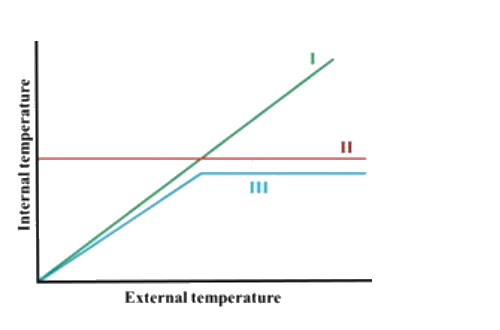After which of the following treatments (I - III) would an enzyme still be expected to have activity?
I. Protease treatment.
II. Heating almost to the point of denaturation.
III. Freezing and then thawing once only.
I only
III only
I and II only
II and III only
The correct Answer is:B
To determine after which treatments an enzyme would still be expected to have activity, we will analyze each treatment step by step.
Step 1: Analyze Treatment I - Protease Treatment
- Explanation: Proteases are enzymes that break down proteins into smaller peptides or amino acids. When an enzyme is treated with proteases, it is likely to be degraded or denatured, leading to a loss of its functional activity.
- Conclusion: After protease treatment, the enzyme is expected to lose its activity.
Hint: Consider how proteases interact with proteins and their effects on enzyme structure.
Step 2: Analyze Treatment II - Heating Almost to the Point of Denaturation
- Explanation: Heating an enzyme can lead to denaturation, where the enzyme's structure is altered, affecting its active site and overall functionality. However, if the heating is not sufficient to fully denature the enzyme, it may still retain some activity.
- Conclusion: If the enzyme is heated only to the point just before complete denaturation, it may still exhibit some activity.
Hint: Think about the temperature range that causes denaturation and how enzymes might retain activity if not fully denatured.
Step 3: Analyze Treatment III - Freezing and Then Thawing Once Only
- Explanation: Freezing can cause changes in the enzyme's structure due to ice crystal formation, which may lead to denaturation. Thawing may not reverse these changes, and the enzyme could become inactive.
- Conclusion: After freezing and thawing, the enzyme is likely to lose its activity.
Hint: Reflect on how temperature changes affect the stability of proteins and enzymes.
Final Conclusion
Based on the analysis:
- Treatment I (Protease treatment) leads to loss of activity.
- Treatment II (Heating almost to the point of denaturation) may retain some activity.
- Treatment III (Freezing and thawing) leads to loss of activity.
Thus, the enzyme would still be expected to have activity after treatments II only.
Correct Answer: Treatment II only.
- Explanation: Proteases are enzymes that break down proteins into smaller peptides or amino acids. When an enzyme is treated with proteases, it is likely to be degraded or denatured, leading to a loss of its functional activity.
- Conclusion: After protease treatment, the enzyme is expected to lose its activity.
- Explanation: Heating an enzyme can lead to denaturation, where the enzyme's structure is altered, affecting its active site and overall functionality. However, if the heating is not sufficient to fully denature the enzyme, it may still retain some activity.
- Conclusion: If the enzyme is heated only to the point just before complete denaturation, it may still exhibit some activity.
- Explanation: Freezing can cause changes in the enzyme's structure due to ice crystal formation, which may lead to denaturation. Thawing may not reverse these changes, and the enzyme could become inactive.
- Conclusion: After freezing and thawing, the enzyme is likely to lose its activity.
Based on the analysis:
- Treatment I (Protease treatment) leads to loss of activity.
- Treatment II (Heating almost to the point of denaturation) may retain some activity.
- Treatment III (Freezing and thawing) leads to loss of activity.
Similar Questions
Which of the following organisms follow the graphs I, II and III respectively ?

View SolutionWhich of the following are perfect cubes? (I)64 (ii) 216 (iii) 243
View SolutionWhich of the following statements are correct for the enzyme Taq polymerase ?
(i) It remains active during the high temperature induced denaturation of dsDNA.
(ii) It requires primers for carrying out the process of polymerisation.
(iii) It synthesises the RNA region between the primers, using dNTPs and Mg2+.
View SolutionWhich of the following are perfect cubes? (I)1000 (ii) 1728 (iii) 3087
View SolutionTc the element below Mn in the periodic table, would be expected to have high values for its :
(I) boiling point , (II) melting point
(III) density
View SolutionWhich of the following statement are correct for the enzyme Taq polymerase?
(i) It remains active during the high temperature .
(ii) It requies primers for carrying out the process of polymerization.
(iii) It induces denaturation of double-stranded DNA.
View Solution_S01_066_Q01.png)
The diagram shows a force extension graph for a rubber band, consider the following statements
(I). It will be easier to compress this rubber than expand it.
(II). Rubber does not return to its original length after it is stretched.
(III). The rubber band will get heated if it is stretched and released.
Which of these can deduced from the graph-
(a). III only
(b). II and III
(c). I and III
(d). I only
View SolutionState which of the following terms connected with change of state of matter i.e. -
a] Melting b] Vaporisation c] Condensation d] Freezing - pertain to -
(i] Conversion of a liquid into a vapour or gas
[ii] Conversion of a liquid into a solid.
[iii] Conversion of a solid into a liquid on heating.
View SolutionThe square of which of the following numbers would be an odd numbers : (I)731 (ii) 3456 (iii) 5559 (iv) 42008
View SolutionWhich of the following are meaningless? (i) "I I ICCC" (ii) KKKCCXI (iii) XD (iv) VC
View Solution
